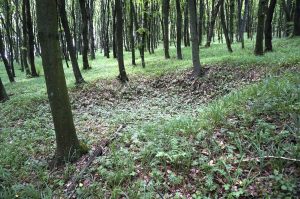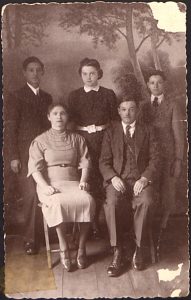(This is a chapter from Jack Glotzer’s memoir, I Survived the German Holocaust Against All Odds. Click here to return to the Table of Contents.)

One of many manmade depressions which could have provided shelter in the forest outside Lopushnia, as seen in 2018.
One morning in the beginning of March 1944 I woke up and I reminded myself that our sack, which we used for carrying potatoes, was torn. We did not have a needle or thread in our hiding place. Since we had only one pair of shoes, Greenberg and I left our hiding place; my cousin and Greenberg’s wife stayed in the hiding place. We went to the Wohls’ hiding place; we knew that there was a needle and thread. The Wohls’ place was approximately 2 km from us. We started to sew the sack. Suddenly we heard shots. It was very hard to distinguish in the woods from what direction the shots were coming because of the echo in the woods. Somehow, I had a feeling that the shots were coming from the direction of our hiding place.
We started to go back, but we were very cautious. As we came closer to our hiding place, we saw a Ukrainian; he wore a uniform. These Ukrainians called themselves “Banderowce”[63] after their leader Bandera. Their mission was to destroy Poles and Jews.[64] He noticed us and started to shoot. We were running. He just kept shooting, but he did not run after us. We knew that there were more of them inside our hiding place. The snow around our hiding place was stained with blood.
We ran back to the Wohls; we told them what was happening. I looked at my coat which I was wearing; it was pierced with burned bullet holes. The bullets did not get to me because the coat was too large for my size. We ran out with the Wohls into a ditch. Deep down in my heart I knew that all the others were dead including my cousin Josie Altman, Greenberg’s wife, and approximately 14 people who were hiding with us.

Altman family studio portrait, probably in Rohatyn, ca. 1938. Seated are Jack’s aunt Malkah and uncle Max; standing left to right are their children Josie, Clara, and Izie.
Josie Altman was 18 years old. We were very close. All our lives we lived in the same house. His mother Malkah Altman was my father’s sister. His father Max Altman emigrated to the USA together with my father. Josie was a very good student. Being with him I still felt that I had a family. After this tragedy I found myself completely alone.
When it got dark, we ran out of the woods to the outskirts of a village. We noticed a house, we knocked on the door. Nobody answered. We walked in. The house was not occupied. We hid there for about two weeks. One day the owner returned; he was a Polish man. When he saw us, he was more scared than we were. He told us that we could stay in the house, because he lived in Łopuszna; once in a while he came to that house.
Around April 1944, when the snow started to melt, we went back to the woods. Somehow, we felt safer in the woods in spite of all the happenings there. Food was constantly a problem. We ate one meal a day, some bread and a potato. What kept us going was the good news about the war which we heard from the Polish people. They told us that the Russian army was as close as Tarnopol, some 70 km from us. That news gave us hope that perhaps we would survive.
One night, at the end of April 1944, we attempted to go down to the village. The village inhabitants were Polish people. One Pole in particular (I do not remember his name), helped us with food. If not for him, we would have died of hunger. There were other Poles in that village who helped us with a good word about the war, which gave us hope. On this particular night as we were going down, we heard shots, and all of a sudden, we saw flames of fire. The Ukrainians found out that the Polish people were helping the Jews.[65] They shot the Polish people and burned their homes. There were children and older people who were shot. It was very shocking to us. Since these people lost their lives because of us, we felt guilty. When we saw them shot around their burned homes, we felt rage and disgust. We had a feeling that our ordeal was coming to an end. The people who helped us to survive should not have been punished. Somehow, I knew in my heart that I would have to take revenge for all what happened. I felt that I had nothing to lose. At that time, I was still hoping that my brother Samuel was alive.
We went back to the woods. One day while baking potatoes, we heard the noise of planes above us. The planes started to shoot (evidently when they saw the smoke), but to our big joy we noticed the Russian star on the planes. We knew that the end of our lives as animals on the run was close. We waited from day to day to hear from the Polish people that the Soviet army was near us. We had to be very careful, since we knew that the Banderowce were on a rampage. They knew that their days were numbered, so they were trying to do as much carnage as they could. Around the end of May 1944, the Soviet army started to advance very fast in our direction from Tarnopol. We were still hiding, hoping that the Soviets would get to us before the Banderowce could. We went from place to place, trying to keep safe.
[63] “Banderowce” (or more commonly “Banderowcy”) is the Polish spelling of the Ukrainian word “Banderivtsi” – or “Banderites” in English – named for Stepan Bandera, leader of the generally younger and more radical faction of the Organization of Ukrainian Nationalists (OUN) from 1940. The term was used by both opponents and supporters of the OUN-B/OUN-R. – Ed. [64] This characterization appears in many Jewish wartime memoirs, but the full picture is much more complex. The main goal of the OUN and other Ukrainian nationalist organizations was to create a non-Soviet independent Ukrainian state. Wartime divisions within the OUN over policy and strategy led to divergent actions and violent internal conflict. The guerrillas targeted the Soviet authorities, the Nazis, and anyone they saw as collaborators with the foreign occupiers, including local Poles, Jews, and Ukrainians. In turn, the Banderites and other nationalists were hunted down and killed by both Soviet and German forces, including in Rohatyn. The encounters described in this memoir were real and deadly. Historians in Ukraine and elsewhere in Europe and North America such as Paul Robert Magocsi, Timothy Snyder, Oleksandr Y. Zaitsev, Taras Kurylo, Volodymyr Viatrovych, John-Paul Himka, Per Anders Rudling, and others have documented and analyzed a larger and more complex picture; that analysis continues. – Ed. [65] In 1943-1944, during World War II and the Nazi occupation, a Ukrainian-Polish conflict with origins in the interwar period took place in Volhynia and Eastern Galicia. Tens of thousands of civilians, both Poles and Ukrainians, were killed in this brutal and bloody ethnic conflict. It is likely that the tragedy Jack describes was connected with this conflict, and not with aid given to Jews. – Ed.
 Published by the Ukrainian Center for Holocaust Studies, (UCHS), Kyiv. This work is licensed under the Creative Commons Attribution-NonCommercial-NoDerivatives 4.0 International License. To view a copy of this license, visit http://creativecommons.org/licenses/by-nc-nd/4.0/ or send a letter to Creative Commons, PO Box 1866, Mountain View, CA 94042, USA.
Published by the Ukrainian Center for Holocaust Studies, (UCHS), Kyiv. This work is licensed under the Creative Commons Attribution-NonCommercial-NoDerivatives 4.0 International License. To view a copy of this license, visit http://creativecommons.org/licenses/by-nc-nd/4.0/ or send a letter to Creative Commons, PO Box 1866, Mountain View, CA 94042, USA.
<- Back to the previous section
